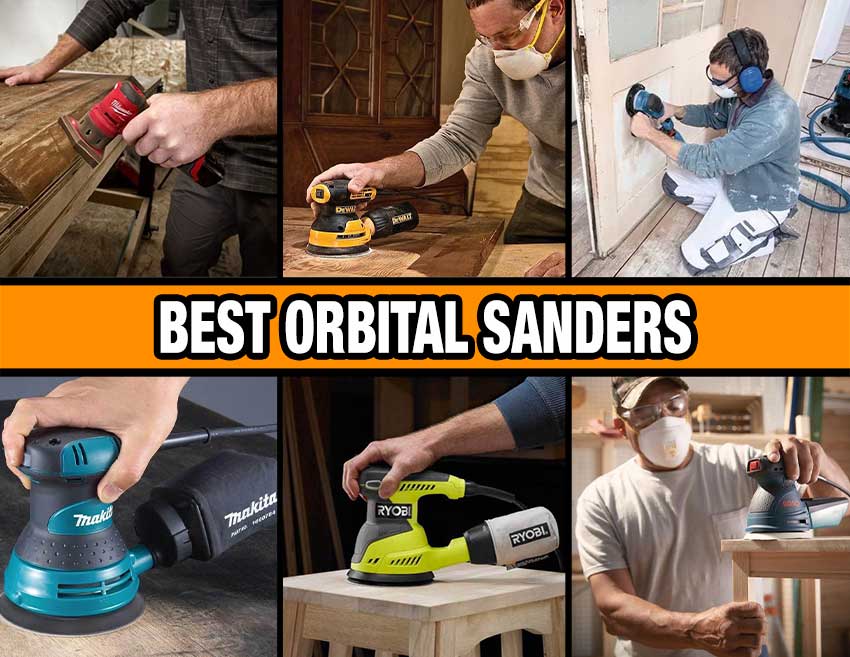There are generally two types of people in this world: Those who love sanding wood and revealing the texture and grain underneath and those who abhor it. Funny enough, folks from these two separate schools of thought agree on one thing, and it’s that having the best random orbital sander makes these projects run more smoothly (pun intended). For the former type of person—that translates to the job being more enjoyable as well.
Random orbital sanders have round pads that grip pieces of sandpaper. The motor spins these pads at high speeds, but instead of spinning around one fixed center point, the center point moves, creating random ellipses rather than perfect circles. This motion quickly removes material but also prevents swirl marks, making these sanders a favorite among DIYers and pros alike. This guide covers our top picks for the best orbital sander across a variety of use cases. After all, not everyone sands the same or uses these tools on the same types of projects.
Our Best Orbital Sander Picks
- Best Overall: Festool ETSC 125
↓ Jump to this Sander - Best Corded: Bosch GET65-5N
↓ Jump to this Sander - Best Value: DeWalt DWE6423K
↓ Jump to this Sander - Most Affordable: Ryobi PCL406
↓ Jump to this Sander - Best Detail Sander: Milwaukee M12 2531
↓ Jump to this Sander - Best for Automotive: Mirka DEROS 550CV
↓ Jump to this Sander
Best Orbital Sander Overall
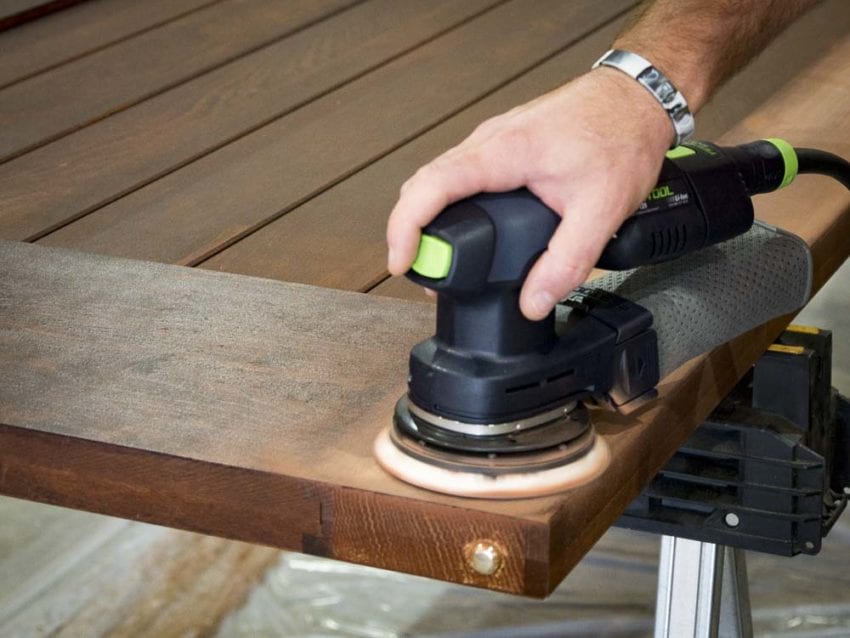
Festool ETSC 125 Hybrid
- Type: Corded-cordless
- Size: 5-inch (125 mm)
- Weight: 1.98 lbs.
- Orbit: 5/64 in. (2 mm)
- Dust extractor port diameter: 1-1/16 in.
- Speed: 6,000–10,000 OPM
There are a lot of great cordless random orbital sanders on the market, but in my opinion, the Festool ETSC 125 cordless orbital sander stands above the rest. This 5-inch random orbital sander features functionality I have yet to see from any other manufacturer. To maintain lower ergonomics and better sanding control, Festool designed a custom battery, especially for these and similar tools. In the process, they also developed an adaptor to allow these tools to use any of their myriad corded dust extractor systems. The result is a tool with the flexibility of battery power but the lightweight, close-to-the-surface option of a corded tool.
This sander weighs less than 2 pounds and uses Festool 3.1 Ah BP 18 Li ERGO-I batteries. You can link the orbital sander with any of several Festool vacuum accessories, including the WCR 1000 Workcenter. You can get the basic version for less, but some sets include multiple batteries, a TCL 6 fast charger, and a power cord adapter to give you endless runtime. The Festool ETSC 125 also uses standard 8-hole, hook-and-loop sanding discs. While we like Festool sanding accessories, you can use any 8-hole discs you like.
Reasons to Buy
- Low-profile battery design
- Removable material protector
- Ships in Systainer SYS3 M 187
- Corded or cordless hybrid functionality
- Backing pad options
Consider Another Model if You…
- Don’t want to pay a premium
Best Corded Orbital Sander
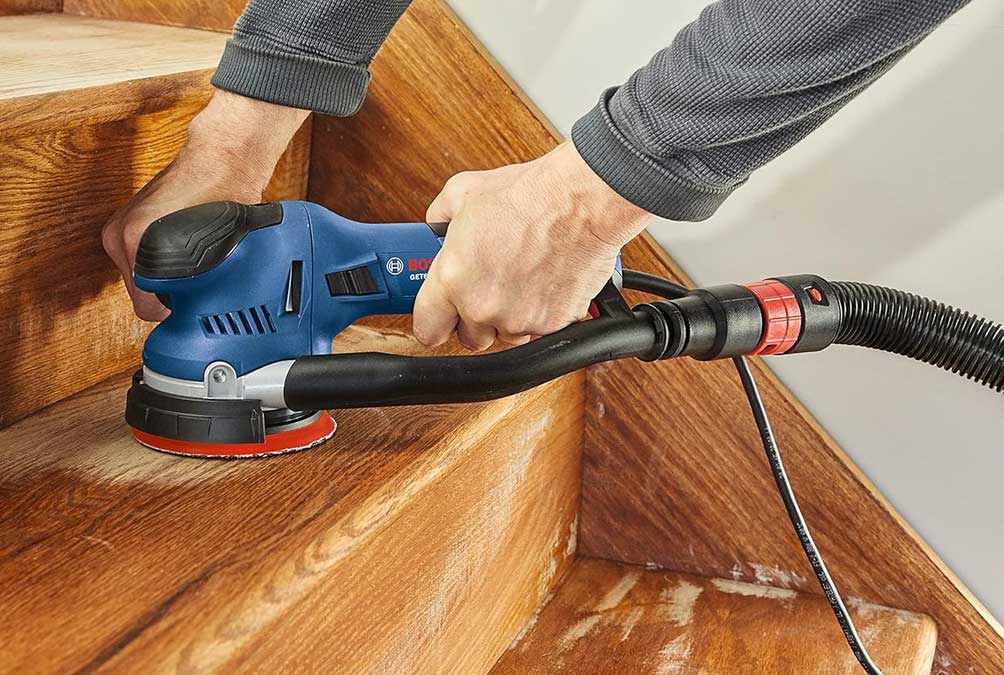
Bosch GET65-5N Dual-Mode
- Type: 6.5A Corded
- Size: 5-inch (125 mm)
- Orbit: 3/32 in. (2.25 mm)
- Dust extractor port: 1.25 in, 1.5 in, 35mm
- Speed: 3,300–7,800 OPM
For professional settings or just heavy-duty sanding, give the GET65-5N from Bosch some consideration. This powerful, 5-inch random orbital sander features a heavy-duty 6.5-amp motor, letting it take on big sanding jobs. It also features adjustable speeds between 3,300 and 7,800 OPM. The key feature for us, however, is the Turbo mode that engages direct drive rotation for fast material removal at 3X the rate of orbital mode.
The Bosch GET65-5N features a built-in dust collection port that is compatible with several Bosch dust collectors. It also comes with a universal adapter for standard 1 ¼-inch and 1 ½-inch hoses and uses multi-hole, hook-and-loop sanding discs. It comes with a medium foam backing pad for general use, but it can easily be swapped for firm or soft pads with the included hex wrench.
Reasons to Buy
- Excellent ergonomics
- Powerful 6.5-amp motor
- Turbo direct-rotation mode for fast material removal
- Connects to multiple dust collection hose sizes
Consider Another Model if You…
- Don’t need to pay the premium for a direct-drive sander
Best Value Random Orbital Sander
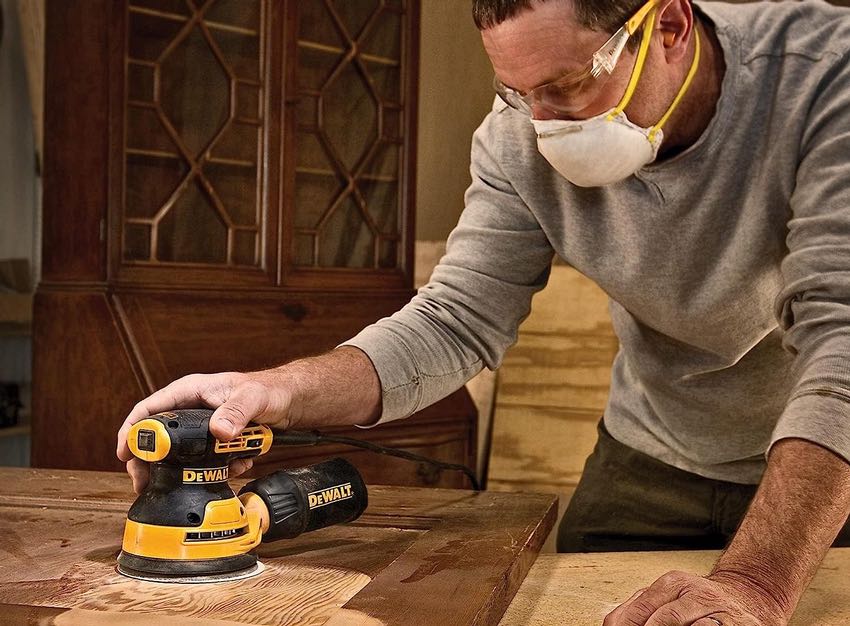
DeWalt DWE6423K
- Type: 3A Corded
- Size: 5-inch (125 mm)
- Orbit: 3/32 in. (2.25 mm)
- Dust extractor port: 1.25 in
- Speed: 8,000–12,000 OPM
The Dewalt DWE6423 Variable Speed Random Orbit Sander is that one sander that does everything well. It features a corded design with a 3-amp motor, and it has adjustable speeds between 8,000 and 12,000 OPM, allowing users to ramp up for aggressive sanding or slow it down for fine-tuning.
This random orbital sander from DeWalt isn’t cordless, but it features a compact design that fits into tight spots. This shorter design also provides a lower center of gravity, allowing for more control and comfort. A counterweight is also built into the device to reduce vibration. The DeWalt also features a one-handed locking dust collection bag that won’t pop off during use, but it does require a special adapter to connect it to a standard 1 ¼-inch vacuum hose. It’s designed for 8-hole, hook-and-loop sanding discs.
Reasons to Buy
- Excellent value
- Adjustable speeds (8,000–12,000 OPM)
- Counterweight reduces vibration
- Compact, low-profile design fits tight spaces
Consider Another Model if You…
- Want more power
Most Affordable Random Orbit Sander
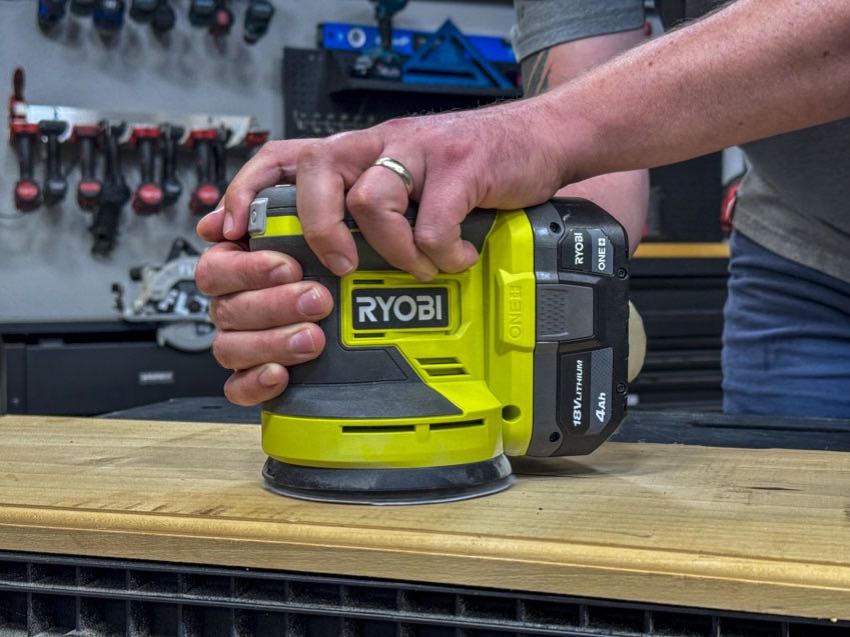
Ryobi PCL406
- Type: Cordless
- Size: 5-inch (125 mm)
- Weight: 2.61 lbs.
- Orbit: 3/32 in. (2.4 mm)
- Dust extractor port diameter: 1-1/4, 1-7/8 in.
- Speed: 10,000 OPM
You don’t get a lot with the Ryobi PCL406 orbital sander except what you see. However, for around $60, you get a compact cordless orbital sander that operates at 10,000 OPM. Unlike a traditional sheet sander, this model has a central mounting point that allows the pad to travel 3/32 inches as well as rotate to help avoid swirl marks.
I find the Ryobi orbital sander to be a big improvement over their previous (corded) model. It loses a little speed, but for smaller projects, a cordless sander works very well and lets you get into and out of a project quickly. It’s perfect for one-handed use but lets you use a second hand when you need a little more finesse. If you’re looking to phase out your older corded sander, this is a great option that’s easy on the hand as well as your wallet.
Reasons to Buy
- Inexpensive sanding solution
- Compact, low-profile design
Consider Another Model if You…
- Want more power or variable speed
- Need a random orbital mode or rotational mode
Best Detail Orbital Sander
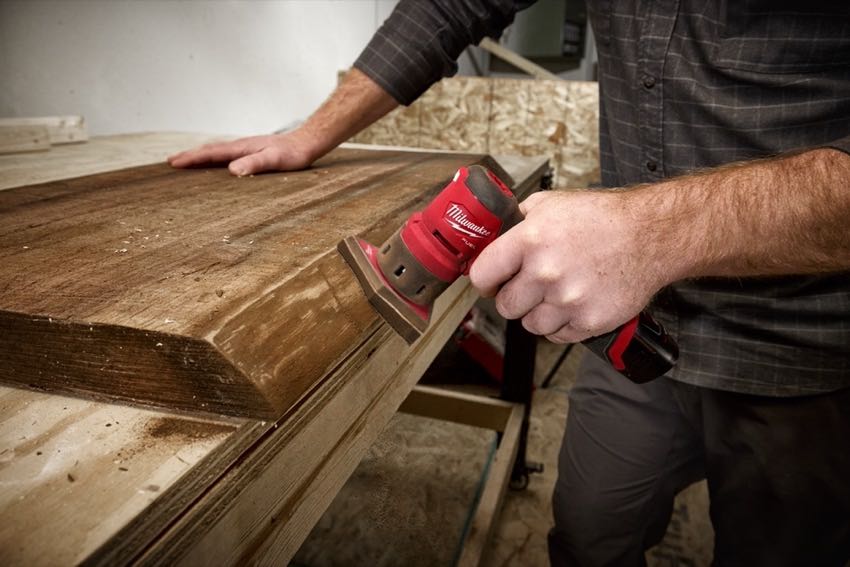
Milwaukee M12 Fuel Detail Sander
- Size: 3×2.5-inch
- Weight: 1.7 lbs. (w/battery)
- Orbit: 1/16 in. (1.5 mm)
- Dust extractor port diameter: 1-1/4, 1-7/8 in.
- Speed: 4,000–14,000 OPM
The Milwaukee 2531 sander serves as a convenient alternative for detail furniture sanding traditionally performed by hand. Its brushless motor employs a 1.5mm diameter orbital sanding motion, significantly accelerating the material removal process compared to hand sanding. This feature greatly minimizes the likelihood of scratches, gouges, and other irregularities, yielding a stain-grade finish.
This tool comes with four preset speed settings, from 4,000 RPM to 14,000 RPM. A lock-on button helps reduce hand fatigue when you have a more intensive job. The unique variable speed trigger also allows for gentle speed adjustments in areas that demand greater control. Uncommon for a sander, this provides a tad more control in my view compared to variable speed dials. Lastly, this tool has so little vibration that your hands and arms will thank you for years to come.
The only downside is the lack of dust control options, so be sure to wear a mask if you’re working on anything indoors or varnished or stained furniture.
Reasons to Buy
- Mesh sheets work amazingly well
- Truly effective random orbit detail sander
- Very ergonomic
Consider Another Model if You…
- Need to remove more material
- Desire all-day runtime
- Need a vacuum attachment
Best Orbital Sander for Automotive Sanding

Mirka DEROS 550CV
- Type: 3A Corded
- Size: 5-inch (125 mm)
- Weight: 2.25 lbs.
- Orbit: 3/16 in. (5 mm)
- Dust extractor port: 1 in
- Speed: 4,000–10,000 OPM
For anyone having used pneumatic sanders, a palm switch feels very natural. That’s one of the top things I like about the Mirka DEROS 550CV. Beyond that, however, you get a sander with very little vibration (Mirka even documents it, unlike most manufacturers). The variable speed random orbital sander has a generous 5mm orbit and produces very little streaking. You also get a separate on/off switch. Suitable for both woodworking and automotive applications, Mirka offers solutions in a wide variety of diameters and oscillating orbits.
Mirka also has some pretty pro-focused features, like a removable power cord. It can be ordered in 14, 21, and 34-foot lengths. While not as perilous as a demo hammer, the options are more about optimizing your shop space when working. Lastly, an electric brake and temperature monitoring round out the professional features I like about this sander.
Reasons to Buy
- Pneumatic-style palm switch
- Various backing pads available
- Replaceable power cords (with 14, 21, and 34 ft. options)
Consider Another Model if You…
- Need a more economical solution
Our Process and the Nitty Gritty
- Why You Can Trust Pro Tool Reviews
- Other Orbital Sanders We Recommend
- Best Sandpaper for Orbital Sanders
- Types of Orbital Sanders
- Best Orbital Sanders Buying Guide
- Frequently Asked Questions about Orbital Sanders
Why You Can Trust Pro Tool Reviews
Ever check out a “review” site, and you can’t tell if they actually tested anything or if they’re just “recommending” the Amazon top sellers? That’s not us. We won’t recommend anything unless we’d use it ourselves, and we don’t care who the primary retailer is. It’s all about giving you a legitimate recommendation and our honest opinion of each product.
Pro Tool Reviews has been covering tools, writing reviews, and reporting on industry news in the construction and lawn care industries since 2008. Each year, we bring in and review more than 350 individual products. Our team will put our hands on hundreds of additional tools at media events and trade shows throughout the year.
Pro Tool Reviews consults with innovators in tool technology and design to gain a broader grasp of where these products fit and how they work. We also extensively consult with them on testing methods, categories, and practical applications.
Our site will provide more than 500 pieces of new content this year absolutely free for our readers. That includes objective evaluations of individual tools and products. The result is information you can trust because of the editorial, scientific, and real-world professional experience we collectively utilize each and every time we pick up and test a tool.
Other Orbital Sanders We Recommend
RIDGID R26011 Random Orbital Sander
If you’re looking for a random orbital sander that will connect to a dust-collecting vacuum right out of the box, consider the R26011 sander from Ridgid. This corded random orbital sander features a sturdy 3-amp motor for plenty of power, and it comes with a dust collection bag that collects up to 90% of dust. But remove that bag, and you can connect directly to most wet/dry vacuum hoses without a tricky little adapter.
This Ridgid random orbital sander features an adjustable speed range between 7,000 and 12,000 OPM. It also has soft start technology, which allows it to slowly ramp up to speed rather than jolting with the flick of a switch, preventing potential gouges. The kit comes with a carrying bag, a dust collection, and two 8-hole, hook-and-loop discs.
Makita BO5031K Variable Speed Random Orbit Sander
Woodworkers tend to work with a lot of different materials, and they need a sander that’s flexible enough to work with all of them. The Makita BO5031K might just be that sander, with an adjustable speed range between 4,000 and 12,000 OPM, allowing users to choose the exact speed they need for the material they’re sanding.
This 5-inch model features a corded, 3-amp motor for plenty of sanding capability. It has a comfortable grip for sanding at a variety of angles, as well as a dust collection bag that slides onto the dust collection port (though an adapter will be necessary to connect it with a dust collection or vacuum hose). It has a 5-inch pad with brake control to reduce gouging upon start-up, and it uses 8-hole, hook-and-loop discs. If you want a front pommel handle, check out the very similar Makita BO5041K.
Ingersoll Rand 5151-6-HL Orbital Sander
Whether it’s a pro shop or a DIY garage, the Ingersoll Rand 5151-6 Random Orbital Sander is up for auto body work. This pneumatic sander connects to a compressor and requires 17.5 CFM of airflow at ~90 PSI to operate. It spins the 6-inch pad at speeds up to 12,000 OPM, allowing for swirl-free finishes in automotive work. It can also be used for sanding wood and other materials.
Unlike many pneumatic sanders, the Ingersoll Rand features a dust collection port that connects with vacuum hoses to keep dust to a minimum—critical in auto body work. It also features a large paddle switch and a rubber grip that provide comfort for long-term sanding projects. It doesn’t come with any air fittings, however, so users will have to install quick-connect fittings to hook it to their air compressor. Also, keep in mind that pneumatic sanders use a lot of air, so a large air compressor is best.
Best Sandpaper for Orbital Sanders
Finding the best orbital sander is the first step in building the perfect setup for your jobs. Next comes the paper you’re sanding with. Our guide to sandpaper types and options will help get you closer to starting your next project.
3M Coarse 80-grit Disc Sandpaper DISC5IN10PK80
Features a universal dust-collection hole design to reduce dust, and it’s available in 80, 100, 120, 150, and 220-grit variations.
DIABLO 5 in. 60-Grit Sanding Disc (50-Pack) DCD050060H50G
Fits 5-inch random orbital sanders with 6 dust collection holes, and it’s available in 60, 100, 150, and 220-grit variations.
DIABLO 5-Inch 80-Grit Universal Hole Sanding Disc DCD050080H50G
Best for aggressive material removal, Diablo’s 5-inch sanding disc features a ceramic blend grit that removes material quickly and aggressively. It fits all 5 and 8-hole sanders.
Gator 5-Inch 50-Pc Aluminum Oxide 180-Grit Disc Sandpaper
Great for finer finishes, Gator’s 5-inch sanding discs are tear-resistant and provide a consistently smooth finished surface. They fit 8-hole sanders.
Dura-Gold 6-Inch Gold PSA Sanding Discs (120 Grit) 39443
With a durable PSA attachment (without any holes), Dura-Gold’s sandpaper is a great option for metal, plastic, fiberglass, and other auto body materials (and it’s available in 40 through 1,000-grit variations).
A random orbital sander is only as good as the paper attached to it. There are two main types, and then several options within those types.
Types of Orbital Sandpaper
The two main types of sandpaper for orbital sanders are hook-and-loop and PSA. Hook-and-loop sandpaper is essentially like Velcro, meaning there are small hooks on the underside of the sanding pad. The hooks cling to loops on fabric on the backside of the sanding paper, and they’re reusable.
PSA sandpaper uses pressure-sensitive adhesive to attach to the bottom of a pneumatic sanding pad. These discs are not reusable.
Grits
Sandpaper comes in grits, which refer to how coarse or fine it is. The lower the number, the coarser (more aggressive) the sandpaper. The higher the number, the finer the finish. For example, 40-grit sandpaper is extremely aggressive and will remove a lot of material quickly but leave deep scratches. On the other hand, 220-grit and 400-grit have finer grit and are less aggressive, making them best for finishing and polishing.
Types of Orbital Sanders
When it comes to choosing a random orbital sander, there are a few things to consider. The main decision, however, comes down to choosing which type is best for your needs: corded, cordless, or pneumatic. Here’s the breakdown of each.
Corded
Corded random orbit sanders use electricity from standard wall outlets to run. They’re generally compact, fairly powerful, and affordable. Many have variable speeds and other settings to make them easier to use or allow them to remove material more quickly. The main drawback is that they’re tethered to a wall or extension cord, and the cord can get in the way.
These sanders are excellent for shop settings where electricity is always available and where cords are not a big deal.
Generally speaking, corded random orbital sanders have motors that draw between 2.5 and 7 amps. The more amperage, the heavier the duty the sander can handle.
Cordless (Battery-Powered)
Cordless random orbit sanders are all about convenience. These models have swappable batteries that allow them to operate without electricity supplied from an outlet. While they used to be subpar when it came to power or speed, today’s models are much more comparable to corded models. However, they’re usually more expensive and require multiple batteries over an entire day of sanding.
They’re great for jobsites, as users can take the sander anywhere without worrying about power.
Cordless random orbital sander power is dependent on the battery voltage. Common batteries include 18- to 20-volt batteries. Battery technology is such that some smaller batteries can still produce a lot of power and sufficient runtime.
Pneumatic
Pneumatic random orbital sanders don’t use electricity at all. Instead, they operate on compressed air, with turbines inside the sander that spin at extremely high speeds when air is applied. This allows these sanders to be relatively low maintenance and simple, lightweight, and very powerful. However, they’re loud and need to be connected to an even louder compressor, and their hoses can get in the way.
These sanders are common in auto body shops where air tools are the norm.
Best Orbital Sanders Buying Guide – What to Look For
Beyond the different types of sanders, there are important features that make some random orbital sanders stand out from the pack. You’ll learn what those features are in the following sections, allowing you to make the best possible decision when choosing a random orbital sander for your needs.
Speed
Speed is one of the top factors to consider when selecting the best random orbital sander. However, the way speed is explained is somewhat tricky.
Most power tools that spin use the term RPM or revolutions per minute to describe their speed. Since random orbit sanders don’t spin in perfect circles, the industry quantifies speed using OPM, or oscillations per minute.
Most DIYers and pros will find a sander with an OPM speed of around 8,000 to be sufficient. However, there are variable speed sanders that allow users to adjust the oscillations per minute to vary the sander’s aggressiveness. In this case, a sander might have a range between 7,000 and 12,000 OPM. Users can choose the speed that works best for their project.
Dust Collection and Holes
Sanders do a great job of removing material, but they turn that material into sawdust in the process. Sawdust can irritate eyes, noses, throats, and airways and, in some cases, cause skin irritation. Large piles of sawdust can also be fire hazards, so it’s a good idea to choose a random orbital sander with dust collection.
Most sanders come with bags that attach to ports, and they direct the sawdust through the port where it collects in the bag. Some models feature cartridge-style bags that also feature an air filter to keep the air as dust-free as possible. Many of these same models are also compatible with dust collection systems or wet/dry vacs to efficiently suck up the dust before it’s a problem.
When to use a dust collection bag or a vacuum is a personal preference. However, a bag can help to minimize the mess when sanding on a job site or when sanding furniture at awkward angles where a hose would get in the way. On the other hand, a vacuum will help remove dust during large sanding projects and could be worth the trouble of the hose.
It’s also important to recognize that certain random orbital sander pads have holes, which allow dust to pass through for dust collection. Most sanders use 8-hole sanding discs, but 5-hole, 6-hole, and multi-hole discs are also popular.
Sanding Disc Size
There are two main random orbital sander sizes, and they include 5- and 6-inch discs. It might not sound like a significant difference, but it’s a big difference in area. A 5-inch circle has a surface area of just over 19.5 square inches, while a 6-inch circle has a surface area of 28.25 square inches, which is an increase of nearly 45 percent. Both sizes have their pros and cons.
Five–inch sanders are more compact and nimble, and they can get into tighter places. They also run at higher speeds, and their sandpaper is typically less expensive. Six-inch sanders are powerful and torquey, but they don’t run at nearly the speed that a 5-inch model does. They also make it difficult to get into tight places and awkward angles.
Most DIYers and pros will find 5-inch models to be the sweet spot. However, for aggressively sanding wide boards and automotive applications, 6 inches is often the preference.
Frequently Asked Questions (FAQs) About Orbital Sanders
There’s more to choosing a random orbital sander than one might think! But, even with all that background, you might still have some questions that need answering. You’re not alone. The following are the most frequently asked questions about random orbital sanders.
Can You Use an Orbital Sander on Drywall?
Random orbital sanders can make short work of drywall sanding. However, it’s important to attach a vacuum or a dust bag at the minimum, as compound dust is very fine and will get everywhere if given the chance. A wet/dry vac is the best option.
Also, these sanders can take a lot of compound (and paper facing) off quickly, so watch the sandpaper grits. Start with something like 150- to 180-grit, and work your way up to 220-grit to finish. A dedicated drywall sander often provides the best results for those looking to maximize their time and effort collecting as much of the drywall dust as possible.
Can I Use an Orbital Sander Between Coats of Polyurethane?
You can, especially if you use a high-grit sandpaper, such as 220 or even 400. However, it’s important to watch how much of the finish you’re removing, so take your time and pay attention.
How to Sand Hardwood Floors with Orbital Sander
You can sand hardwood floors with a random orbital sander, but it takes longer and requires greater attention to detail than sanding with a floor sander. The trick is to start with an aggressive sandpaper grit, like 80 to 100 grit, to remove the majority of the finish. Remove all of the sanding dust and then finish sanding with a finer grit, like 120 to 150 grit.
Can You Sand Concrete With an Orbital Sander?
You can sand concrete with a random orbital sander. To start, use an aggressive grit, such as 30 to 60, and then move up to 80—to 120-grit paper for smoothing. Concrete dust is very fine, so wear a mask and attach a wet/dry vacuum for the best results.
Can You Use an Orbital Sander as a Buffer?
Yes, you can use an orbital sander as a buffer, but you have to use the correct pads first. Swap out the existing pad for a foam polishing pad and work slowly. Random orbital sanders don’t have as much power or surface area as an auto-body buffer, so it will take longer, but it can be done.
Can You Wet Sand With an Orbital Sander?
Wet sanding is the last step in fine-tuning a perfect surface, and random orbital sanders aren’t exactly fine-tuning tools. You’re better off sanding the surface by hand to ensure that it’s tuned to perfection. However, if you do use a random orbital sander to wet sand, make sure to guard the tool from getting wet and use a GFCI outlet for protection, and even so, you might risk electrocution.

